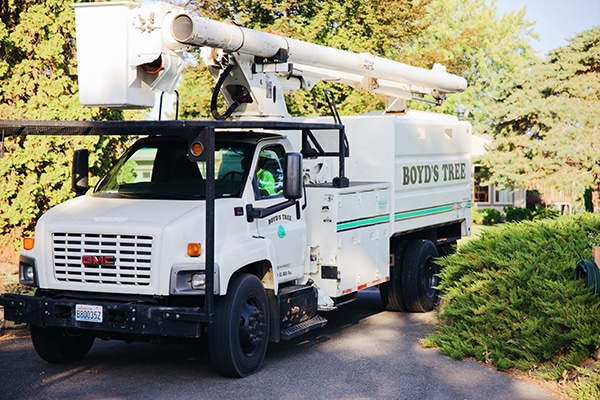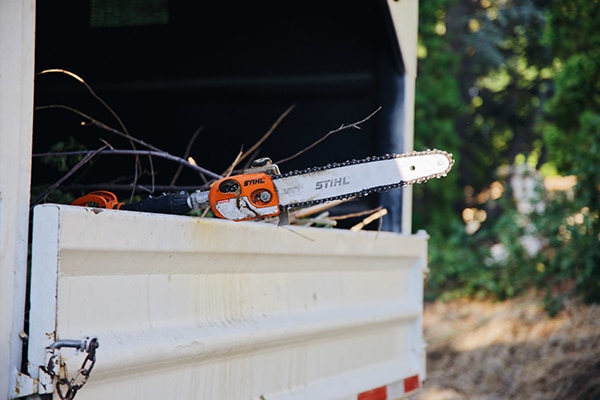Trees are an important part of our landscape as they add beauty and a calming presence in our every-day lives. They also shade our homes and neighborhoods, reducing our energy costs. Trees increase property values, reduce air pollution, and curtail soil erosion. They also provide habitat for wildlife.
As trees are a peaceful, serene part of the background, it is easy to neglect them and forget that they need our care to survive and thrive. Proper tree maintenance is vital to their continued growth and ongoing health.
Tips to Keep Trees Healthy
Keep Grass Away: Trees have to compete with grass for air, water and nutrients when the grass grows up against the tree trunk. Grass growing right up against the trunk especially stunts the growth and development of young trees. For best results, maintain a grass-free, mulched area around the tree trunk.
Fertilize as Needed: Feeding trees depends largely on the age of the tree. For example, young trees need occasional fertilizing until they are established. However, mature trees do not require food or nutrients at all. The time to feed a tree is when it is growing poorly or it has yellowing foliage. Use a soil test to verify which nutrients are necessary for a tree.
Protect the Roots: Cars and heavy equipment should be prohibited from driving over the root areas of trees. When they do, they compact the soil, which reduces available oxygen and can kill the roots. Consult a certified arborist before removing or adding soil beneath tree canopies. Impacting grades also brings harm to roots and weakens trees, sometimes killing them or leaving them more prone to storm damage.
Protect the Trunk: Among the ways you can damage bark and the trunk are by bumping trees with lawn mowers or whipping the trunks with weed-eaters. These actions structurally weaken the tree while also leaving trees susceptible to insects and disease. It is advised that you protect trees, particularly young trees, by using plastic wraps that are available at nurseries and garden centers. Ideally, you maintain a 2-foot to 3-foot wide grass-free, mulched ring around the tree.
Mulch Regularly: It is best to mulch around the base of your trees – with the exception of trees in a woodland area. Add a 1-to 4-inch layer of wood chips or shredded bark, pine needles, shredded autumn leaves, cocoa hulls, straw or other biodegradable mulch. Try putting the mulch 1 inch or 2 inches from the tree trunk, extending as far as the drip line, or at least 3 feet away from the base of the trunk. Mulch has several benefits to your trees that include protecting your tree from lawn equipment, suppressing weeds, and retaining moisture in the soil.
Trim Back on Pruning: Some neglect is permissible when it comes to pruning your trees. Mature trees rarely need much pruning, other than getting rid of dead or damaged branches and trimming off any suckers that shoot up at the base. Crowded growth on mature branches – especially those of fruit trees – called water sprouts, should frequently be trimmed, as should any running or problem branches.
Know Your Trees and Your Diseases: While trees typically require minimal maintenance, it is a good idea to observe them carefully. Many diseases are specific only to certain species of trees, so in order to accurately diagnose a problem, you will need to know the tree type. You might access a helpful tree reference book to assist in this process.
Walk Your Property: Take a walk around your property frequently as you examine your trees. Check leaves and branches for signs of insects or insect activity, as well as dead twigs, and mushrooms growing on or around the base of the tree. Also look for odd spots on leaves.
Watch Where You Dig: The most common killer of trees is construction – especially when heavy equipment is involved. Consider the scenario involving a Missouri couple who designed the driveway of their new house around a beautiful 200-year-old tree. They laid the driveway and the tree promptly died.
Even in circumstances where construction appears far away from trees, remember that a root system can stretch two to three times farther than the branches. When it comes to a mature tree, heavy equipment operating as far as 60 feet away can still compact the soil and damage the roots, causing a tree to die in a few months or gradually over a period of years.
Whether laying a driveway or building a shed, consider meeting with a contractor and make clear where heavy equipment can and cannot go. It’s helpful to mark off around trees during construction. Stake off areas at least 10 feet from the drip line of the tree, that is, as far as the branches of the tree extend.

Let Boyd’s Tree Service Help Keep Your Trees Healthy
At Boyd’s Tree Service, we are a full-service tree and stump removal business that serves the Tri-Cities and surrounding areas. We pride ourselves on always making sure the trees in our communities are healthy and beautiful.
Boyd’s Tree Service has the tools, supplies, and experience to keep your trees and yard looking their best with a range of trimming, removal, and cleaning services.
For more information, we invite you to call Boyd’s Tree Service at (509) 585-4194.







